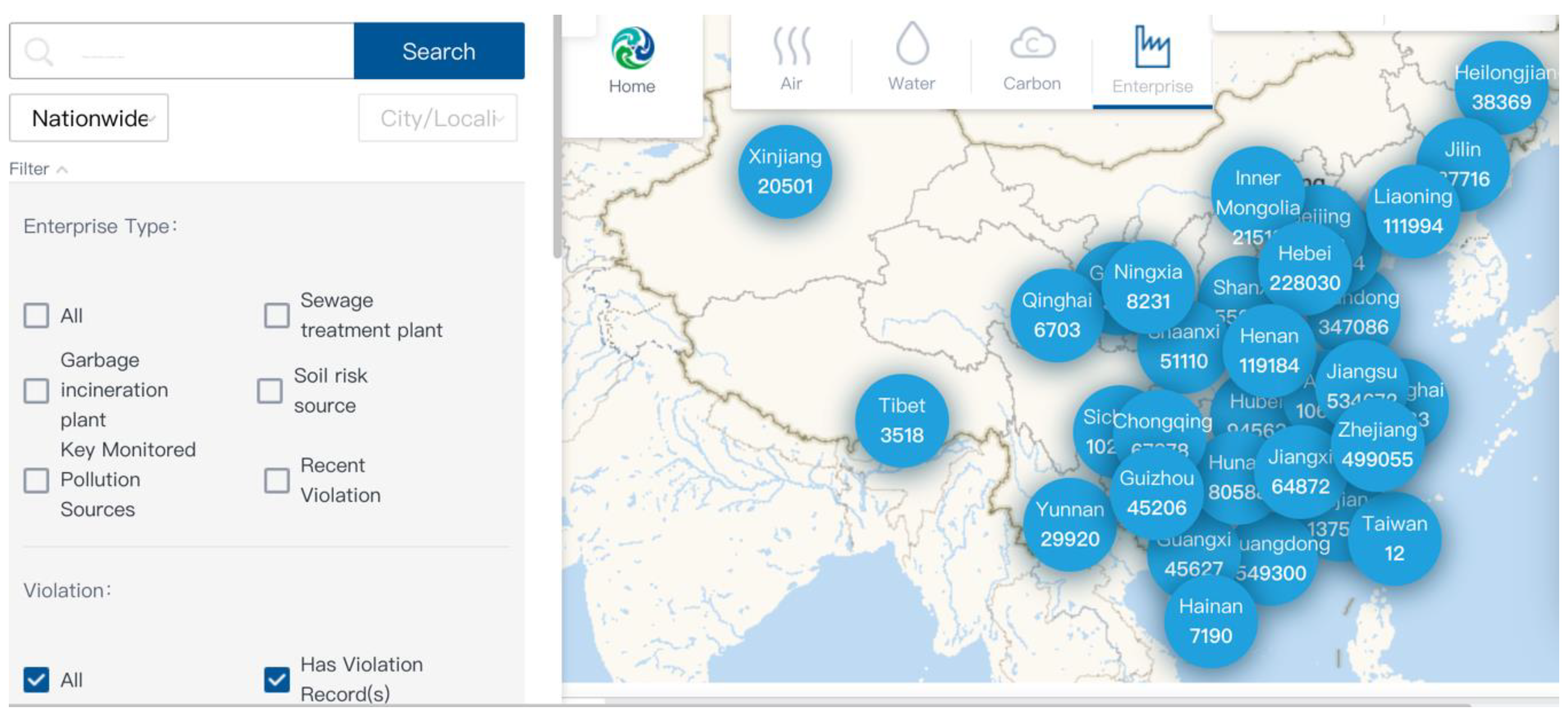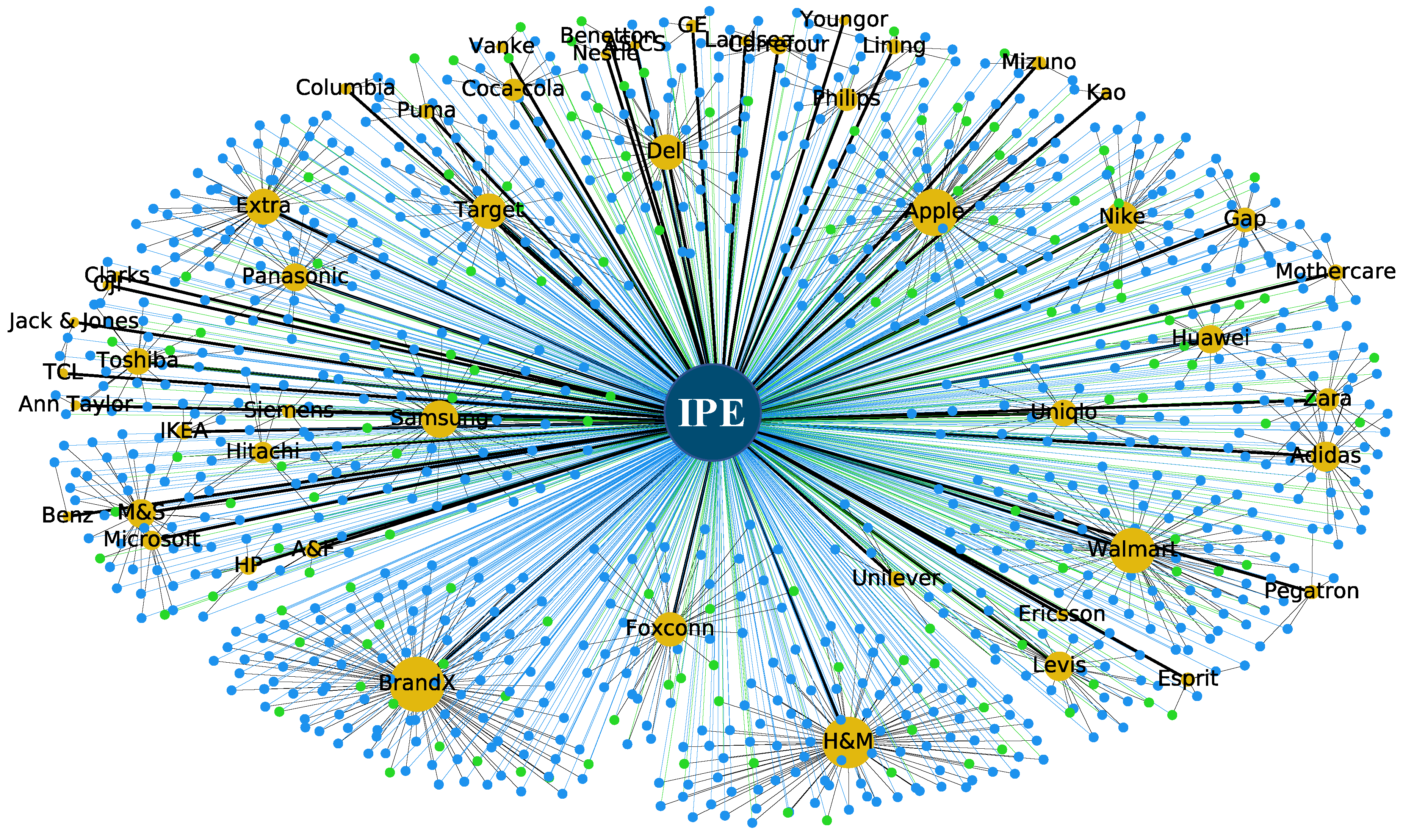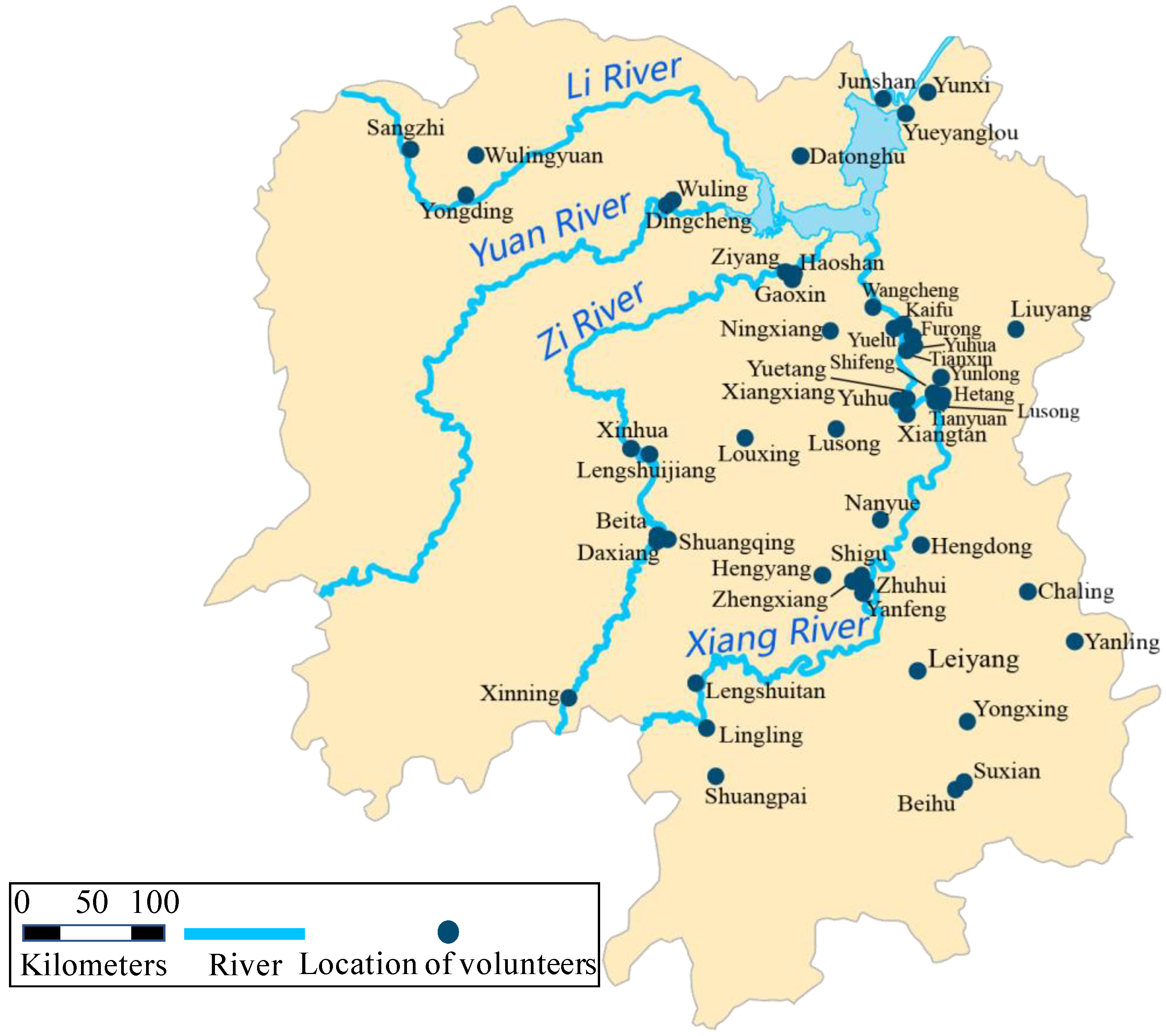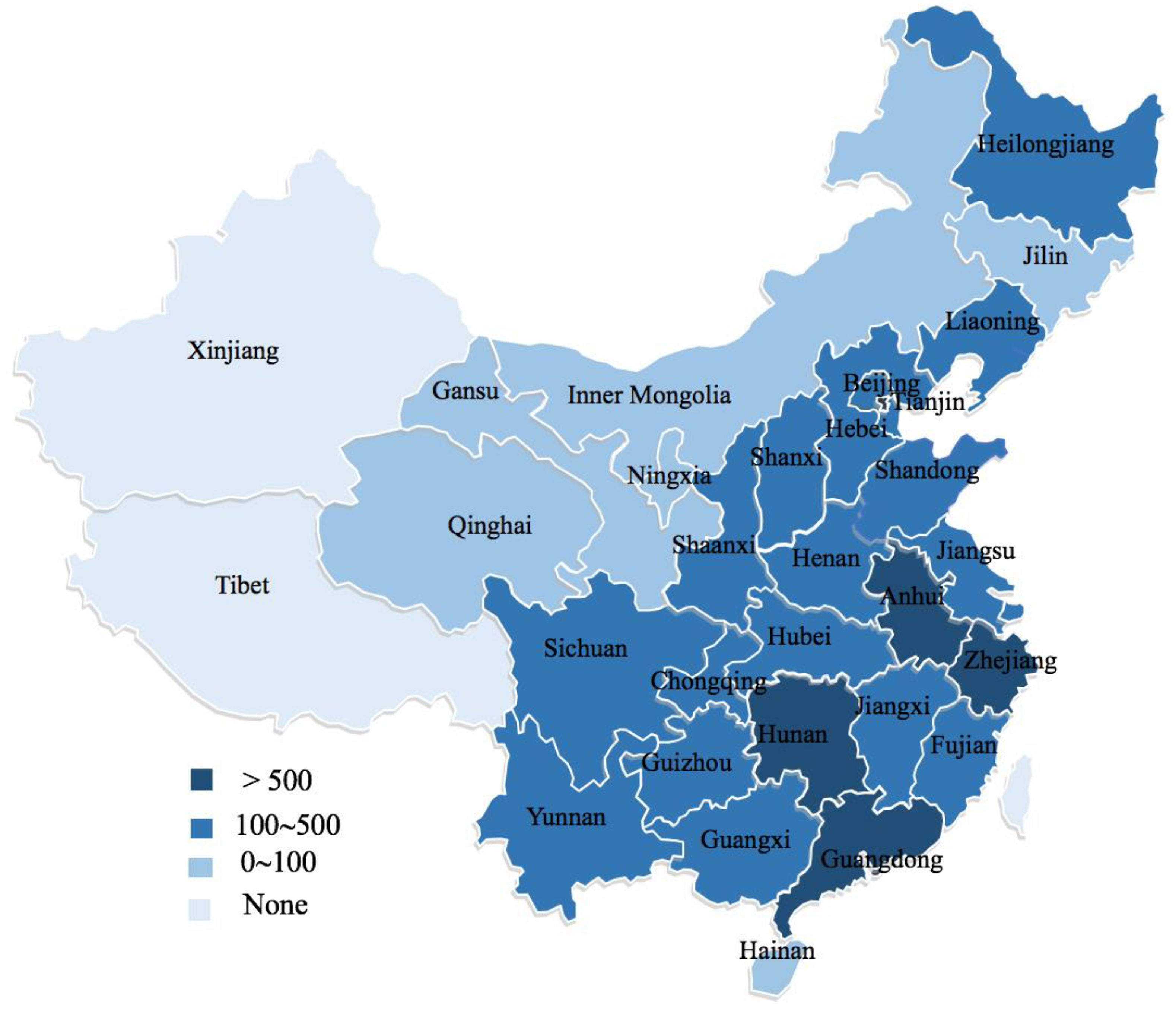Environmental Activism and Big Data: Building Green Social Capital in China
Abstract
1. Introduction
2. Theoretical Foundation
3. Method: Design of Multiple-Case Studies
4. Empirical Findings
4.1. The Institute of Public and Environmental (IPE) Affairs
4.1.1. Green Supply Chain Management
4.1.2. Structural Social Capital: IPE–Brand-Sensitive Multinational Corporations (MNCs)–Chinese Suppliers’ Network
4.1.3. Cognitive Social Capital: Greening the Supply Chain and Business-Environmental Non-Government Organizations (ENGO) Partnerships
4.2. Green Hunan
4.2.1. A Mobile Data-Based Riverwatcher Action Network
4.2.2. Mobile App-Based Structural Social Capital
4.2.3. Cognitive Social Capital: Three-Dimensional Value Orientations Towards Water Pollution
5. Discussion
Supplementary Materials
Author Contributions
Funding
Acknowledgments
Conflicts of Interest
References
- Fedorenko, I.; Sun, Y. Microblogging-Based Civic Participation on Environment in China: A Case Study of the PM 2.5 Campaign. Voluntas 2016, 27, 2077–2105. [Google Scholar] [CrossRef]
- Yang, G. The Co-Evolution of the Internet and Civil Society in China. Asian Surv. 2003, 43, 405–422. [Google Scholar] [CrossRef]
- McNutt, J.; Guo, C.; Goldkind, L.; An, S. Technology in Nonprofit Organizations and Voluntary Action; BRILL: Leiden, The Netherlands, 2018. [Google Scholar]
- Liu, J. Picturing a Green Virtual Public Space for Social Change: A Study of Internet Activism and Web-Based Environmental Collective Actions in China. Chin. J. Commun. 2011, 4, 137–166. [Google Scholar] [CrossRef]
- Yang, G. Environmental NGOs and Institutional Dynamics in China. China Q. 2005, 181, 46–66. [Google Scholar] [CrossRef]
- Yang, G.; Calhoun, C. Media, Civil Society, and the Rise of a Green Public Sphere in China. China Inf. 2007, 21, 211–236. [Google Scholar] [CrossRef]
- Sima, Y. Grassroots Environmental Activism and the Internet: Constructing a Green Public Sphere in China. Asian Stud. Rev. 2011, 35, 477–497. [Google Scholar] [CrossRef]
- Sullivan, J.; Xie, L. Environmental Activism, Social Networks and the Internet. China Q. 2009, 198, 422–432. [Google Scholar] [CrossRef]
- Constantinides, E.; Fountain, S.J. Web 2.0: Conceptual Foundations and Marketing Issues. J. Direct Data Digit. Mark. Pract. 2008, 9, 231–244. [Google Scholar] [CrossRef]
- Anderson, P. What Is Web 2.0? Ideas, Technologies and Implications for Education. JISC Technol. Stand. Watch 2007. Available online: https://www.webarchive.org.uk/wayback/archive/20140613220103/http://www.jisc.ac.uk/media/documents/techwatch/tsw0701b.pdf (accessed on 11 November 2019).
- Blank, G.; Reisdorf, B.C. THE PARTICIPATORY WEB: A User Perspective on Web 2.0. Inf. Commun. Soc. 2012, 15, 537–554. [Google Scholar] [CrossRef]
- Goodchild, M.F. Citizens as Voluntary Sensors: Spatial Data Infrastructure in the World of Web 2.0. Int. J. Spat. Data Infrastruct. Res. 2007, 2, 24–32. [Google Scholar]
- Guo, C.; Saxton, G.D. Tweeting Social Change: How Social Media Are Changing Nonprofit Advocacy. Nonprofit Volunt. Sect. Q. 2014, 43, 57–79. [Google Scholar] [CrossRef]
- Hendler, J. Web 3.0 Emerging. IEEE Comput. Soc. 2009, 42, 111–113. [Google Scholar] [CrossRef]
- Gobble, M.M. Big Data: The Next Big Thing in Innovation. Res.-Technol. Manag. 2013, 56, 64–67. [Google Scholar] [CrossRef]
- Qin, S.J. Process Data Analytics in the Era of Big Data. AIChE J. 2014, 60, 3092–3100. [Google Scholar] [CrossRef]
- Chinese Central Environmental Monitoring Station. Available online: http://www.cnemc.cn/sssj/ (accessed on 1 September 2019).
- McAfee, A.; Brynjolfsson, E. Big Data: The Management Revolution. Harv. Bus. Rev. 2012, 90, 60–66. [Google Scholar] [PubMed]
- The Annual report of Green Hunan 2015. Available online: http://test.greenhunan.org.cn/index.php?v=show&cid=56&id=232 (accessed on 3 June 2019).
- Keeso, A. Big Data and Environmental Sustainability: A Conversation Starter; Smith School Working Paper Series 2014-04; University of Oxford: Oxford, UK, 2014. [Google Scholar]
- Sizer, N.; Cheung, L.; Anderson, J. Counting Trees to Save the Woods: Using Big Data to Map Deforestation; World Resources Institute: Washington, DC, USA, 2014; Available online: https://www.wri.org/blog/2014/10/counting-trees-save-woods-using-big-data-map-deforestation (accessed on 9 March 2020).
- Logan, K. Vietnam and Third-Wave Data: How Environmental NGOs Are Leveraging Data to Improve Air Quality Governance; Data Driven Envirolab: Singapore, 2019; Available online: https://datadrivenlab.org/air-quality-2/vietnam-and-third-wave-data-how-environmental-ngos-are-leveraging-data-to-improve-air-quality-governance/ (accessed on 7 March 2020).
- Villars, R.L.; Eastwood, M.; Olofson, C.W. WHITE PAPER Big Data: What It Is and Why You Should Care; International Data Corporation: Framingham, MA, USA, 2011; Available online: file:///Users/jingxu/Downloads/IDC_Big%20Data_whitepaper_final.pdf (accessed on 21 December 2019).
- Hilbert, M. Big Data for Development: A Review of Promises and Challenges. Dev. Policy Rev. 2016, 34, 135. [Google Scholar] [CrossRef]
- Williams, S. More Than Data: Working with Big Data for Civics. J. Law Policy Inf. Soc. 2015, 11, 181–199. [Google Scholar]
- Suebvises, P. Social Capital, Citizen Participation in Public Administration, and Public Sector Performance in Thailand. World Dev. 2018, 109, 236–248. [Google Scholar] [CrossRef]
- Díaz Andrade, A.E.; Urquhart, C. The Value of Extended Networks: Social Capital in an ICT Intervention in Rural Peru. Inf. Technol. Dev. 2009, 15, 108–132. [Google Scholar] [CrossRef]
- Molony, T. Carving a Niche: ICT, Social Capital, and Trust in the Shift from Personal to Impersonal Trading in Tanzania. Inf. Technol. Dev. 2009, 15, 283–301. [Google Scholar] [CrossRef]
- Sum, S.; Mathews, M.R.; Pourghasem, M.; Hughes, I. Internet Technology and Social Capital: How the Internet Affects Seniors’ Social Capital and Wellbeing. J. Comput.-Med. Commun. 2008, 14, 202–220. [Google Scholar] [CrossRef]
- Thapa, D.; Sein, M.K.; Sæbø, Ø. Building Collective Capabilities through ICT in a Mountain Region of Nepal: Where Social Capital Leads to Collective Action. Inf. Technol. Dev. 2012, 18, 5–22. [Google Scholar] [CrossRef]
- Townsend, L.; Wallace, C.; Smart, A.; Norman, T. Building Virtual Bridges: How Rural Micro-Enterprises Develop Social Capital in Online and Face-to-Face Settings: Building Virtual Bridges. Sociol. Rural. 2016, 56, 29–47. [Google Scholar] [CrossRef]
- Alam, K.; Imran, S. The Digital Divide and Social Inclusion among Refugee Migrants: A Case in Regional Australia. Inf. Technol. People 2015, 28, 344–365. [Google Scholar] [CrossRef]
- Shim, D.C.; Eom, T.H.; Hondeghem, A.; Perry, J.L. Anticorruption Effects of Information Communication and Technology (ICT) and Social Capital. Int. Rev. Adm. Sci. 2009, 75, 99–116. [Google Scholar] [CrossRef]
- Mignone, J.; Henley, H. Impact of Information and Communication Technology on Social Capital in Aboriginal Communities in Canada. J. Inf. 2009, 4, 127–145. [Google Scholar] [CrossRef]
- Lin, N. Building a Network Theory of Social Capital. Connections 1999, 22, 28–51. [Google Scholar]
- Putnam, R.D. Bowling Alone: America’s Declining Social Capital. J. Democr. 1995, 6, 65–78. [Google Scholar] [CrossRef]
- Szreter, S. Health by Association? Social Capital, Social Theory, and the Political Economy of Public Health. Int. J. Epidemiol. 2004, 33, 650–667. [Google Scholar] [CrossRef]
- Kawachi, I. Commentary: Reconciling the Three Accounts of Social Capital. Int. J. Epidemiol. 2004, 33, 682–690. [Google Scholar] [CrossRef]
- Westlund, H.; Gawell, M. Building Social Capital for Social Entrepreneurship. Ann. Public Cooperative Econ. 2012, 83, 101–116. [Google Scholar] [CrossRef]
- Aldrich, D.P.; Meyer, M.A. Social Capital and Community Resilience. Am. Behav. Sci. 2015, 59, 254–269. [Google Scholar] [CrossRef]
- Coleman, J.S. Social Capital in the Creation of Human Capital. Am. J. Sociol. 1988, 94, S95–S120. [Google Scholar] [CrossRef]
- Maseda, M.P.; Neira, I.; Del Mar Salinas-Jiménez, M. Social Capital and Subjective Wellbeing in Europe: A New Approach on Social Capital. Soc. Indic. Res. 2013, 114, 493–511. [Google Scholar]
- McDougall, C.; Banjade, M.R. Social Capital, Conflict, and Adaptive Collaborative Governance: Exploring the Dialectic. Ecol. Soc. 2015, 20, 44. [Google Scholar] [CrossRef]
- Putnam, R.D. Tuning In, Tuning Out: The Strange Disappearance of Social Capital in America. Political Sci. Politics 1995, 28, 664. [Google Scholar] [CrossRef]
- Nahapiet, J.; Ghoshal, S. Social Capital, Intellectual Capital, and the Organizational Advantage. Acad. Manag. Rev. 1998, 23, 242–266. [Google Scholar] [CrossRef]
- Adler, P.S.; Kwon, S.-W. Social Capital: Prospects for a New Concept. Acad. Manag. Rev. 2002, 27, 17–40. [Google Scholar] [CrossRef]
- Lin, N.; Erickson, B.H. Theory, Measurement, and the Research Enterprise on Social Capital. In Social Capital; Lin, N., Erickson, B.H., Eds.; Oxford University Press: New York, NY, USA, 2008; pp. 1–24. [Google Scholar]
- Hawkins, R.L.; Maurer, K. Unravelling Social Capital: Disentangling a Concept for Social Work. Br. J. Soc. Work 2012, 42, 353–370. [Google Scholar] [CrossRef]
- Payne, G.T.; Moore, C.B.; Griffis, S.E.; Autry, C.W. Multilevel Challenges and Opportunities in Social Capital Research. J. Manag. 2011, 37, 491–520. [Google Scholar] [CrossRef]
- Williams, K.; Durrance, J.C. Social Networks and Social Capital: Rethinking Theory in Community Informatics. J. Commun. Inf. 2008, 4, 1–20. [Google Scholar]
- Robert, L.P.; Dennis, A.R.; Ahuja, M.K. Social Capital and Knowledge Integration in Digitally Enabled Teams. Inf. Syst. Res. 2008, 19, 314–334. [Google Scholar] [CrossRef]
- Tsai, W. Social Capital and Value Creation: The Role of Intrafirm Networks. Acad. Manag. Rev. 1998, 41, 464–476. [Google Scholar]
- Kwon, S.-W.; Adler, P.S. Social Capital: Maturation of a Field of Research. Acad. Manag. Rev. 2014, 39, 412–422. [Google Scholar] [CrossRef]
- Oh, Y.; Bush, C.B. Exploring the Role of Dynamic Social Capital in Collaborative Governance. Adm. Soc. 2016, 48, 216–236. [Google Scholar] [CrossRef]
- Inkpen, A.C.; Tsang, E.W.K. Social Capital, Networks, and Knowledge Transfer. Acad. Manag. Rev. 2005, 30, 146–165. [Google Scholar] [CrossRef]
- Villena, V.H.; Revilla, E.; Choi, T.Y. The Dark Side of Buyer-Supplier Relationships: A Social Capital Perspective. J. Oper. Manag. 2011, 29, 561–576. [Google Scholar] [CrossRef]
- Bolino, M.C.; Turnley, W.H. Citizenship Behavior and the Creation of Social Capital in Organizations. Acad. Manag. Rev. 2002, 27, 505–522. [Google Scholar] [CrossRef]
- Yin, R.K. Case Study Research: Design and Methods; Sage Publications: Thousand Oaks, CA, USA, 2009; pp. 1–65. [Google Scholar]
- Crowe, S.; Cresswell, K.; Robertson, A.; Huby, G.; Avery, A.; Sheikh, A. The Case Study Approach. BMC Med. Res. Methodol. 2011, 11, 100. [Google Scholar] [CrossRef]
- Flyvbjerg, B. Five Misunderstandings About Case-Study Research. Qual. Inq. 2006, 12, 219–245. [Google Scholar] [CrossRef]
- Harberg, A.A.; Schult, D.A.; Swart, P.J. Exploring Network Structure, Dynamics, and Function Using Network X. In Proceedings of the 7th Python in Science Conference, Pasadena, CA, USA, 21 August 2008. [Google Scholar]
- Hammarberg, K.; de Lacey, S.; Kirkman, M. Qualitative Research Methods: When to Use Them and How to Judge Them. Hum. Reprod. 2016, 31, 498–501. [Google Scholar] [CrossRef] [PubMed]
- Hsien, H.; Shannon, S.E. The Approaches to Qualitative Content Analysis. Qual. Health Res. 2005, 15, 1277–1288. [Google Scholar]
- Zhang, L.; Mol, A.P.; He, G. Transparency and Information Disclosure in China’s Environmental Governance. Curr. Opin. Environ. Sustain. 2016, 18, 17–24. [Google Scholar] [CrossRef]
- Jagadish, H.V.; Gehrke, J.; Labrinidis, A.; Papakonstantinou, Y.; Patel, J.M.; Ramakrishnan, R.; Shahabi, C. Big Data and Its Technical Challenges. Commun. ACM 2014, 57, 86–94. [Google Scholar] [CrossRef]
- Cafarella, M.J.; Halevy, A.; Khoussainova, N. Data Integration for the Relational Web. Proc. VLDB Endow. 2009, 2, 1090–1101. [Google Scholar] [CrossRef]
- Chen, M.; Mao, S.; Liu, Y. Big Data: A Survey. Mobile Netw. Appl. 2014, 19, 171–209. [Google Scholar] [CrossRef]
- Chen, C.L.P.; Zhang, C.-Y. Data-Intensive Applications, Challenges, Techniques and Technologies: A Survey on Big Data. Inf. Sci. 2014, 275, 314–347. [Google Scholar] [CrossRef]
- Kitchin, R. Big Data, New Epistemologies and Paradigm Shifts. Big Data Soc. 2014, 1, 1–12. [Google Scholar] [CrossRef]
- Wamba, S.F.; Akter, S.; Edwards, A.; Chopin, G.; Gnanzou, D. How ‘Big Data’ Can Make Big Impact: Findings from a Systematic Review and a Longitudinal Case Study. Int. J. Prod. Econ. 2015, 165, 234–246. [Google Scholar] [CrossRef]
- Kim, G.-H.; Trimi, S.; Chung, J.-H. Big-Data Applications in the Government Sector. Commun. ACM 2014, 57, 78–85. [Google Scholar] [CrossRef]
- Chen, J.; Chen, Y.; Du, X.; Li, C.; Lu, J.; Zhao, S.; Zhou, X. Big Data Challenge: A Data Management Perspective. Front. Comput. Sci. 2013, 7, 157–164. [Google Scholar] [CrossRef]
- Emani, C.; Cullot, N.; Nicolle, C. Understandable Big Data: A Survey. Comput. Sci. Rev. 2015, 17, 70–81. [Google Scholar] [CrossRef]
- Erevelles, S.; Fukawa, N.; Swayne, L. Big Data Consumer Analytics and the Transformation of Marketing. J. Bus. Res. 2016, 69, 897–904. [Google Scholar] [CrossRef]
- Greening Supply Chains in China: Practical Lessons from China-Based Suppliers in Achieving Environmental Performance. Available online: http://wwwoa.ipe.org.cn//Upload/Report-Green-Supply-Chain-In-China-EN.pdf (accessed on 2 November 2019).
- Haddad, M.A. Increasing Environmental Performance in a Context of Low Governmental Enforcement: Evidence From China. J. Environ. Dev. 2015, 24, 3–25. [Google Scholar] [CrossRef]
- Environmental map database of IPE. Available online: http://wwwen.ipe.org.cn/AirMap_fxy/AirMap.html (accessed on 28 December 2019).
- Greening the Global Supply Chain: CITI Index 2016 Annual Evaluation Report. Available online: http://wwwoa.ipe.org.cn//Upload/201610271208391846.pdf (accessed on 6 October 2019).
- The Python package NetworkX. Available online: https://networkx.github.io (accessed on 14 October 2019).
- Tan, Y. Transparency without Democracy: The Unexpected Effects of China’s Environmental Disclosure Policy: Transparency without Democracy. Governance 2014, 27, 37–62. [Google Scholar] [CrossRef]
- The Methods to Deal with Environmental Supervision Records of Enterprises. Available online: http://wwwoa.ipe.org.cn///Plugin/KindEditor/Upload/file/20190805/20190805133318_1983.pdf (accessed on 12 October 2019).
- Green Supply Chain Map. Available online: http://www.ipe.org.cn/MapBrand/Brand.html?q=6 (accessed on 17 October 2019).
- Greening the Global Supply Chain: CITI Index 2018 Annual Evaluation Report Summary. Available online: http://wwwoa.ipe.org.cn//Upload/201810310312375653.pdf (accessed on 20 October 2019).
- Ahmadi, H.B.; Kusi-Sarpong, S.; Rezaei, J. Assessing the Social Sustainability of Supply Chains Using Best Worst Method. Resources. Conserv. Recycl. 2017, 126, 99–106. [Google Scholar] [CrossRef]
- Queiroz, M.M. A Framework for Sustainable Supply Chain in Emerging Economies. Environ. Qual. Manag. 2019, 28, 7–15. [Google Scholar] [CrossRef]
- Tekin, E.K.; Ertürk, A.; Tozan, H. Corporate Social Responsibility in Supply Chains; IntechOpen: London, UK, 2015. [Google Scholar] [CrossRef]
- Hajikhani, M. Considering on Green Supply Chain Management Drivers, as a Strategic Organizational Development Approach. Malays. Perspect. 2012, 6, 246–265. [Google Scholar]
- Martusa, R. Green Supply Chain Management: Strategy to Gain Competitive Advantage. J. Energy Technol. Policy 2013, 3, 334–341. [Google Scholar]
- Qiu, X. (IPE, Beijing, China). Personal Communication, 2018.
- Swoboda, B.; Puchert, C.; Morschett, D. Explaining the Differing Effects of Corporate Reputation across Nations: A Multilevel Analysis. J. Acad. Mark. Sci. 2016, 44, 454–473. [Google Scholar] [CrossRef]
- Fombrun, C.J. A World of Reputation Research, Analysis and Thinking — Building Corporate Reputation Through CSR Initiatives: Evolving Standards. Corp. Reput. Rev. 2005, 8, 7–12. [Google Scholar] [CrossRef]
- Consumers’ Green Choices Prompt IT Brands to Break Salience. Available online: http://wwwoa.ipe.org.cn/Upload//2010-09/d5279562d85140709ccc132d22a64b6b.pdf (accessed on 6 October 2019).
- Zhang, J.Y.; Barr, M. Green Politics in China: Environmental Governance and State-society Relations; Pluto Press: London, UK, 2012; pp. 78–90. [Google Scholar]
- Stafford, E.R.; Polonsky, M.J.; Hartman, C.L. Environmental NGO-Business Collaboration and Strategic Bridging: A Case Analysis of the Greenpeace-Foron Alliance. Bus. Strat. Environ. 2000, 9, 122–135. [Google Scholar] [CrossRef]
- The Annual Report of Green Hunan 2011. Available online: http://www.greenhunan.org.cn/fileadmin/user_upload/%E7%BB%BF%E8%89%B2%E6%BD%87%E6%B9%982011%E5%B9%B4%E5%B9%B4%E5%BA%A6%E6%8A%A5%E5%91%8A.pdf (accessed on 16 December 2019).
- The Annual Report of Green Hunan 2012. Available online: http://www.greenhunan.org.cn/fileadmin/user_upload/%E7%BB%BF%E8%89%B2%E6%BD%87%E6%B9%982012%E5%B9%B4%E5%B7%A5%E4%BD%9C%E5%B9%B4%E6%8A%A5.pdf (accessed on 18 December 2019).
- The Annual Report of Green Hunan 2013. Available online: http://www.greenhunan.org.cn/fileadmin/user_upload/%E7%BB%BF%E8%89%B2%E6%BD%87%E6%B9%982013%E5%B9%B4%E5%B9%B4%E5%BA%A6%E5%B7%A5%E4%BD%9C%E6%8A%A5%E5%91%8A.pdf (accessed on 18 December 2019).
- The Annual Report of Green Hunan 2014. Available online: http://www.greenhunan.org.cn/fileadmin/user_upload/2014%E5%B9%B4%E7%BB%BF%E8%89%B2%E6%BD%87%E6%B9%98%E5%B9%B4%E5%BA%A6%E5%B7%A5%E4%BD%9C%E6%8A%A5%E5%91%8A.pdf (accessed on 19 December 2019).
- Jiang, X. (Green Hunan, Hunan, China). Personal Communication, 2019.
- China Mobile Phone Users 2013–2019. Available online: https://www.statista.com/statistics/233291/forecast-of-mobile-phone-users-in-china (accessed on 21 October 2019).
- The Monthly Report of the Riverwatcher Action Network in November 2019. Available online: https://mp.weixin.qq.com/s/abl3xxUYOCw_mmz56w2ukQ (accessed on 18 December 2019).
- The Monthly Reports of the Riverwatcher Action Network in April, May, July, August, September, December 2019. Available online: http://www.rwan.org.cn/riverpatrol/activity/monthlyreport.html (accessed on 20 December 2019).
- Alibeli, M.A.; White, N.R. The Structure of Environmental Concern. Int. J. Bus. Soc. Sci. 2011, 2, 8. [Google Scholar]
- Bolderdijk, J.W.; Gorsira, M.; Keizer, K.; Steg, L. Values Determine the (In) Effectiveness of Informational Interventions in Promoting Pro-Environmental Behavior. PLoS ONE 2013, 8, e83911. [Google Scholar] [CrossRef]
- De Groot, J.I.M.; Steg, L. Value Orientations and Environmental Beliefs in Five Countries: Validity of an Instrument to Measure Egoistic, Altruistic and Biospheric Value Orientations. J. Cross Cult. Psychol. 2007, 38, 318–332. [Google Scholar] [CrossRef]
- Ryan, A.M.; Spash, C.L. The Awareness of Consequences Scale: An Exploration, Empirical Analysis, and Reinterpretation: Awareness of Consequences Scale. J. Appl. Soc. Psychol. 2012, 42, 2505–2540. [Google Scholar] [CrossRef]
- Sahin, E. Predictors of Turkish Elementary Teacher Candidates’ Energy Conservation Behaviors: An Approach on Value-Belief-Norm Theory. Int. J. Environ. Sci. Educa. 2013, 8, 269–283. [Google Scholar] [CrossRef]
- Schultz, P.W.; Zelezny, L. Reframing Environmental Messages to Be Congruent with American Values. Hum. Ecol. Rev. 2003, 10, 11. [Google Scholar]
- China’s National Environmental Statistics. Available online: http://m.mee.gov.cn/gzfw/hjtj/qghjtjgb (accessed on 12 April 2019).
- A series of Volunteers’ Stories in the Riverwatcher Action Network—Yuan Genliang. Available online: http://www.rwan.org.cn/project/rivers/character.html?tx_news_pi1%5Bnews%5D=196&cHash=fd693c665be0241243ed51d411640ff1 (accessed on 24 December 2019).
- A series of Volunteers’ Stories in the Riverwatcher Action Network—Xie Zongbing. Available online: http://www.rwan.org.cn/project/rivers/character.html?tx_news_pi1%5Bnews%5D=197&cHash=78a688a331f6d99b7e44846ff09608ab (accessed on 24 December 2019).
- Miao, X.; Tang, Y.; Wong, W.Y.; Zang, H. The latent causal chain of Industrial water pollution in China. Environ. Pollut. 2015, 196, 473–477. [Google Scholar] [CrossRef]
- Economy, E. Environmental governance in China: State control to crisis management. Am. Acad. Arts Sci. 2014, 143, 185–197. [Google Scholar] [CrossRef]
- Tao, T.; Xin, K. Public health: A sustainable plan for China’s drinking water. Nature 2014, 511, 527–528. [Google Scholar] [CrossRef] [PubMed]
- Shapiro, J. China’s Environmental Challenges; Polity Press: Cambridge, MA, USA, 2012; pp. 1–33. [Google Scholar]
- China Youth News: A Survey Shows that 71.8% Respondents Feel that They Are under the Threat of Water Pollution. Available online: http://zqb.cyol.com/html/2013-02/07/nw.D110000zgqnb_20130207_1-07.htm (accessed on 10 March 2019).
- A Series of Volunteers’ Stories in the Riverwatcher Action Network—Zhang Zhibiao. Available online: http://www.rwan.org.cn/project/rivers/character.html?tx_news_pi1%5Bnews%5D=74&cHash=83f9ef41747810bd411e98c311d99910 (accessed on 24 December 2019).
- A Series of Volunteers’ Stories in the Riverwatcher Action Network—Kuang Hui. Available online: http://www.rwan.org.cn/project/rivers/character.html?tx_news_pi1%5Bnews%5D=170&cHash=8c5f49b4a769bcfc4744112fd369a0e8 (accessed on 24 December 2019).
- A Series of Volunteers’ Stories in the Riverwatcher Action Network—Ou Bangrong. Available online: http://www.rwan.org.cn/project/rivers/character.html?tx_news_pi1%5Bnews%5D=60&cHash=f911200151e2872d25bb38665aa9dd75 (accessed on 24 December 2019).
- Stoker, G. Governance as Theory: Five Propositions. Int. Soc. Sci. J. 1998, 50, 17–28. [Google Scholar] [CrossRef]
- Yu, J.; Guo, S. Civil Society and Governance in China; Palgrave Macmillan: New York, NY, USA, 2012; pp. 4–5. [Google Scholar]
- Jiang, M.; Fu, K.-W. Chinese Social Media and Big Data: Big Data, Big Brother, Big Profit? Chinese Social Media and Big Data. Policy Internet 2018, 10, 372–392. [Google Scholar] [CrossRef]





| Case Study | Analysis Unit | Data Sources | Methodologies for Data Analysis |
|---|---|---|---|
| IPE | Structural Social Capital | The website of IPE 45 technical reports and project reports produced by IPE 3 annual reports of IPE 7 archival documents 2 interviews with IPE representatives Academic publications | Theoretically informed qualitative content analysis Quantitative social network analysis via Python package NetworkX |
| Cognitive Social Capital | 2 interviews with IPE representatives 3 annual reports of IPE Academic publications | Theoretically informed qualitative content analysis | |
| Green Hunan | Structural Social Capital | The website of Riverwatcher The mobile app of Riverwatcher 5 annual reports of Green Hunan 2 annual reports of Riverwatcher 10 monthly reports of Riverwatcher 1 interview with a Green Hunan representative | Theoretically informed qualitative content analysis Quantitative data analysis via equation solving |
| Cognitive Social Capital | 22 archival documents Academic publications | Theoretically-informed qualitative content analysis |
| Theme | Code # | Code | Description |
|---|---|---|---|
| Social interactions and relations | R1 | IPE–MNCs | Communication and engagement between IPE and MNCs about the identification and resolution of pollution problems in the supply chain |
| R2 | MNCs–polluting suppliers | MNCs’ interacting with polluting suppliers | |
| R3 | Polluting suppliers–IPE | Manner of engagement of polluting suppliers with IPE to address pollution problems | |
| R4 | Green Hunan–volunteers | Volunteers’ participation in Green Hunan’s Riverwatcher Action Network | |
| R5 | Volunteers–volunteers | Interactions in volunteers’ monitoring groups | |
| Shared concern and objective | O1 | MNCs’ motivation | MNCs’ concerns about corporation reputation and profitability |
| O2 | Polluting suppliers’ motivation | Polluting suppliers’ concerns about losing business | |
| O3 | Volunteers’ social–altruistic attitudes | Volunteers’ concerns about damage caused by water pollution in communities | |
| O4 | Volunteers’ biospheric value orientations | Volunteers’ concerns about the river itself | |
| O5 | Volunteers’ egoistic motivations | Volunteers’ concerns about their own interests affected by water pollution | |
| Shared culture | C1 | Greening the supply Chain | Rules and norms in IPE’s green supply chain network |
| C2 | Monitoring water pollution | Manner of f volunteer participation in the Riverwatcher Action Network |
| Type of Data | Volume | Velocity | Variety |
|---|---|---|---|
| Air Quality | Data on air quality index (AQI), PM2.5, PM10, SO2, NO2, O3, and CO from 4092 monitoring stations nationwide | Real-time data every hour | Web data, text documents |
| Water Quality | Data on water quality grades from 23,344 monitoring stations nationwide | Real-time data every four hours; real-time weekly or monthly data | Web data, text documents |
| Air Pollution Emission | Data on air pollutant concentrations (NOx, SO2, and dust) from 7917 primary sources of air pollution | Real-time data every hour | Web data, text documents |
| Water Pollution Discharge | Data on water pollutant concentrations (COD, pH, NH3-N) from 15,646 primary sources of water pollution | Real-time data every hour | Web data, text documents |
| Environmental Violation Records of Enterprises | Over 1,545,000 violation records of more than 1,052,700 polluting enterprises (date, type, cause, penalty, inspectors of environmental violations, and correction and verification information) | Updated per day | Web data, text documents images |
© 2020 by the authors. Licensee MDPI, Basel, Switzerland. This article is an open access article distributed under the terms and conditions of the Creative Commons Attribution (CC BY) license (http://creativecommons.org/licenses/by/4.0/).
Share and Cite
Xu, J.; Zhang, H. Environmental Activism and Big Data: Building Green Social Capital in China. Sustainability 2020, 12, 3386. https://doi.org/10.3390/su12083386
Xu J, Zhang H. Environmental Activism and Big Data: Building Green Social Capital in China. Sustainability. 2020; 12(8):3386. https://doi.org/10.3390/su12083386
Chicago/Turabian StyleXu, Jing, and Huijun Zhang. 2020. "Environmental Activism and Big Data: Building Green Social Capital in China" Sustainability 12, no. 8: 3386. https://doi.org/10.3390/su12083386
APA StyleXu, J., & Zhang, H. (2020). Environmental Activism and Big Data: Building Green Social Capital in China. Sustainability, 12(8), 3386. https://doi.org/10.3390/su12083386





